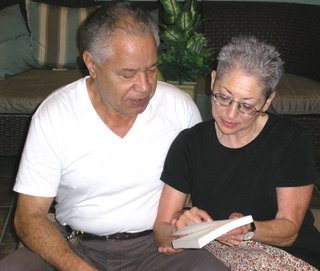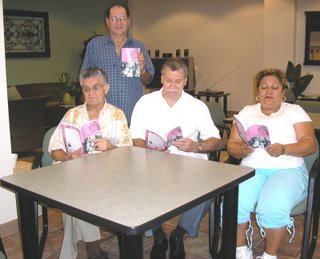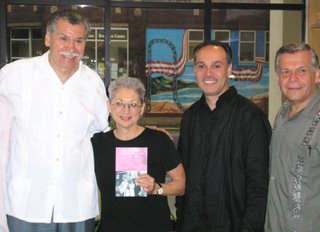
Sometimes, the things that bind us to our own culture can also link us to others. That’s the lesson I learned July 20 when I visited the Teresa Roldan Apartments on Paseo Boricua at 2501-11 W. Division St. in my old Humboldt Park neighborhood. Constructed by the Hispanic Housing Development Corp. (HHDC) for those 55 and older, the five-story, 59-unit affordable rental building was designed to reflect an architectural style typical of buildings in Old San Juan, Puerto Rico.
My original goal was to see the property that had blossomed on the site of my childhood home and grocery store – the places I describe in my memoir, “The Division Street Princess.” Also, I hoped to donate signed copies of my book to the building’s library. But thanks to the residents of the Roldan apartments and leaders of the Humboldt Park community whom I met that day, that intent soon evolved into a heart-to-heart conversation that proved enlightening for all.
When I consider my Jewish heritage, I’m blessed by concern for family and a desire to make life better for those we love. In the 1940s, that took shape in my parents’ American dream of education for their kids (immigrants from Russia, my dad –- one of six -- never went to high school, let along college; Mom and her seven siblings graduated from Tuley high school) and economic success for their mom-and-pop grocery store.
During my visit to my old neighborhood, I found that same concern and dream along Paseo Boricua, the section of Division Street anchored by two, 45-town steel Puerto Rican flags. I learned that our similarities trumped differences. True, shopkeepers now sprinkle their patter with Spanish instead of Yiddish, building facades can be sunburst yellow instead of faded red brick, and a sleek No.70 Division Street bus speeds along its asphalt path rather than the old Red Pullman that was hooked to overhead cables and ran along streetcar tracks.
But these changes are simply history book entries that color an era, give evidence to what came before and what is now. They are links, not barriers. Guideposts, not fences.
The men and women I met during my visit to Paseo Boricua welcomed me as if I were their own returning daughter, and they shared their stories: Paul Roldan, president of the HHDC, told me how his parents met on New York’s Lower East Side despite growing up in the same Puerto Rican town, Aqua Villa. Ignacio De La Rosa, who had owned a grocery in the neighborhood like my parents, said he loved the same statue I had placed in my memoir – the one at the entry to Humboldt Park and now needing attention and repair. Pablo Pepsin, Sr., a longtime resident of the community, studied my father’s photo on “The Division Street Princess” book cover, and said, “I knew him. I shopped in your store.”

Pablo Pepin, Sr. and me.

Left to right: Ignacio DeLaRosa, Paul Roldan, and Candida R. Agron. Standing Angel Lopez
Along with Roldan, I met other community leaders, like highly respected Billy Ocasio, alderman of the 26th Ward for the past 10 years who has fought to halt discrimination, and encourage affordable housing, economic development, and school reform.

Left to right: Paul Roldan, president, Hispanic Housing Development Corp.; me, Billy Ocasio, Alderman 26th Ward; and Jose E. Lopez, executive director, Puerto Rican Cultural Center
Enrique Salgado, Jr., is executive director of the Division Street Business Development Association (DSBDA), a 22-year-old organization that nurtures and enriches the neighborhood by celebrating the cultural heritage of residents, and at the same time, striving for economic success for business owners. The steel Puerto Rican flags, plus stabilization of existing shops, and influx of new businesses and jobs, are testimony to the DSBDA’s progress.
Jose E. Lopez, executive director of the Puerto Rican Cultural Center, which is considered the intellectual anchor of the community, also serves as local historian. Lopez and the Center promote social service programs to answer health and educational needs while reaffirming the neighborhood’s cultural legacy.
My visit culminated at lunch in Nellie’s Restaurant, 2458 W. Division St. (773-252-5520), cattycorner from Irv’s Finer Foods (1940s) and the Teresa Roldan Apartments (2006). And yes, I found another similarity between our heritages: we love food! I enjoyed a delicious ceviche salad recommended by Lopez, while enviously sampling Roldan’s plate of fried pork and plantains. (Note to kosher or Weight Watcher friends: I know, I know…)
This visit to Division Street in its reincarnation as Paseo Boricua, encouraged me to declare myself an honorary hija; and my new friends -- sensing an ally to their cause – are including me and “The Division Street Princess” in future plans. Watch this space for more ways this grocer’s daughter and Paseo Boricua’s residents will work together to prove that history, plus respect and admiration, can link, rather than separate, people who truly care about their families, their community, their city, and yes, their cultural heritages.

Today's immigrants much like early arrivals
July 22, 2006
BY SUE ONTIVEROS SUN-TIMES COLUMNIST

Stirring the melting pot
July 27, 2006
BY TIMOTHY INKLEBARGER, Staff Writer
CHICAGO JOURNAL
No comments:
Post a Comment